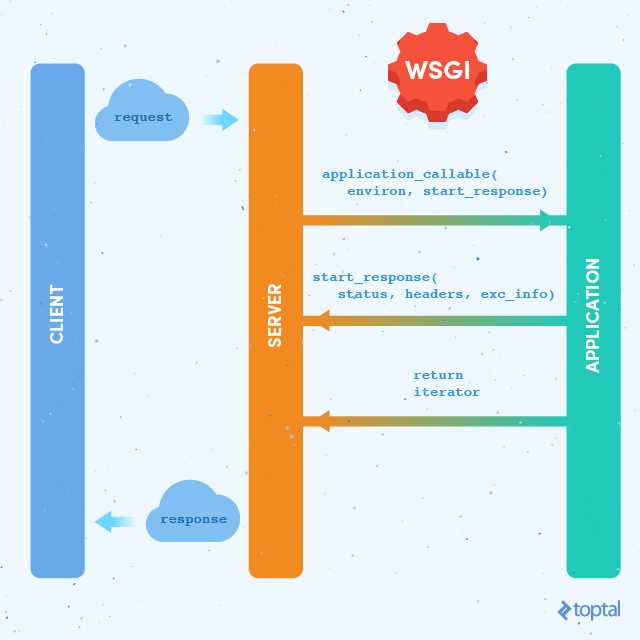标签:ret 运行 header server start tornado inter 解析 通用
WSGI全称为Python Web Server Gateway Interface,Python Web服务器网关接口,它是介于Web服务器和Web应用程序(或Web框架)之间的一种简单而通用的接口。

我们知道,客户端和服务器端之间进行沟通遵循HTTP协议。但是我们用Python所编写的很多Web程序,并不会直接去处理HTTP请求,因为这太复杂了。所以WSGI诞生了,使从HTTP请求和Web程序之间,多了一种转换过程——从HTTP报文转换成WSGI的数据格式。这个时候,我们的Web程序就可以建立在WSGI之上,直接去处理WSGI解析给我们的请求,而我们就可以专注于Web程序本身的编写。
WSGI接口定义的非常简单。根据WSGI的规定,Web程序(即WSGI程序)必须是一个可调用的对象,这个可调用对象可以是函数、方法、类或是实现了__call__方法的类实例。这个可调用的对象接收两个参数:
另外,这个可调用对象的还要返回一个可迭代的对象。
我们看一个简单的WSGI程序
def index(environ, start_response):
status = '200 OK'
response_header = [('Content-type', 'text/html')]
start_response(status, response_header)
yield b'<h1>Hello WSGi</h1>'根据WSGI的定义,请求和响应的主体应为字节串,所以我们在这里返回的html格式字符串上加上了b前缀将其声明为bytes类型
现在我们的Web程序(WSGI程序)编写好了,就需要一个WSGI服务器来运行它。Python提供了一个wsgiref库,我们可以在开发时进行使用。
完善上面的WSGI程序如下:
from wsgiref.simple_server import make_server
def index(environ, start_response):
status = '200 OK'
response_header = [('Content-type', 'text/html')]
start_response(status, response_header)
yield b'<h1>Hello WSGi</h1>'
server = make_server('localhost', 5000, index)
server.serve_forever()我们使用make_server(host, port, application)方法创建了一个本地服务器,分别传入主机地址、端口和可调用对象。然后使用server_forever()方法来运行它。当在shell中运行后,在浏览器中输入localhost:5000就可以看到我们编写的效果了。
WSGI服务器在启动后会监听本地端口,当收到请求时,他会将请求报文解析成一个environ字典,然后将其传给WSGI程序,同时传递start_response函数。当我们的WSGI程序将请求处理完后,会通过start_response方法来通知WSGI服务器来发起一个响应,并设置相应的响应头,然后返回响应的主体。然后WSGI服务器再将其解析成HTTP格式,返回给客户端。你也可以通过上面的图片来理解这个过程。
WSGI允许使用中间件(Middleware)来包装Web程序,在程序在调用前添加额外的设置和属性。这个特性常用来解耦程序的功能。
我们也可以给我们的程序添加一个中间件
from wsgiref.simple_server import make_server
def index(environ, start_response):
status = '200 OK'
response_header = [('Content-type', 'text/html')]
start_response(status, response_header)
yield b'<h1>Hello WSGi</h1>'
class Middleware(object):
def __init__(self, web_app):
self.web_app = web_app
def __call__(self, environ, start_response):
def before_start_response(status, header):
header.append(('middleware', 'middleware'))
return start_response(status, header)
return self.web_app(environ, before_start_response)
new_index = Middleware(index)
server = make_server('localhost', 5000, new_index)
server.serve_forever()这里我们使用实现了__call__方法的类实例来创建WSGI的可调用对象。并通过这个中间件来为我们的Web程序添加了一个响应头(尽管这没有意义)。真正的中间件远比我们这里实现的复杂、功能强大的多。而且往往不止一个中间件,而是一个中间件堆栈,通过层层包装,实现了非常多的功能。
现在有了WSGI,我们可以很容易实现一个Python Web程序,但是这还是不够方便,于是有了Web框架。
Python Web框架是在WSGI的上面又抽象出来一层,使之更易使用,编写的Python Web程序也更易维护。
我们以非常著名的Flask框架为例。重新实现一下上面的WSGI程序。
from flask import Flask
app = Flask(__name__)
@app.route('/')
def index():
return '<h1>Hello WSGi</h1>'
app.run()另外,Python还有很多流行的Web框架,例如Django,web.py、Tornado等,这里不在详细展开。
参考资料:
https://zh.wikipedia.org/wiki/Web%E6%9C%8D%E5%8A%A1%E5%99%A8%E7%BD%91%E5%85%B3%E6%8E%A5%E5%8F%A3
《Flask Web开发实战》
标签:ret 运行 header server start tornado inter 解析 通用
原文地址:https://www.cnblogs.com/tcctw/p/10662934.html